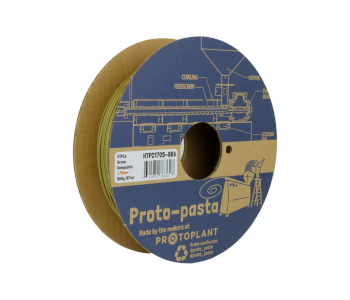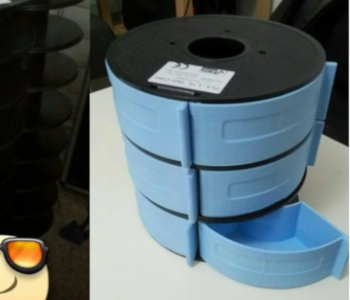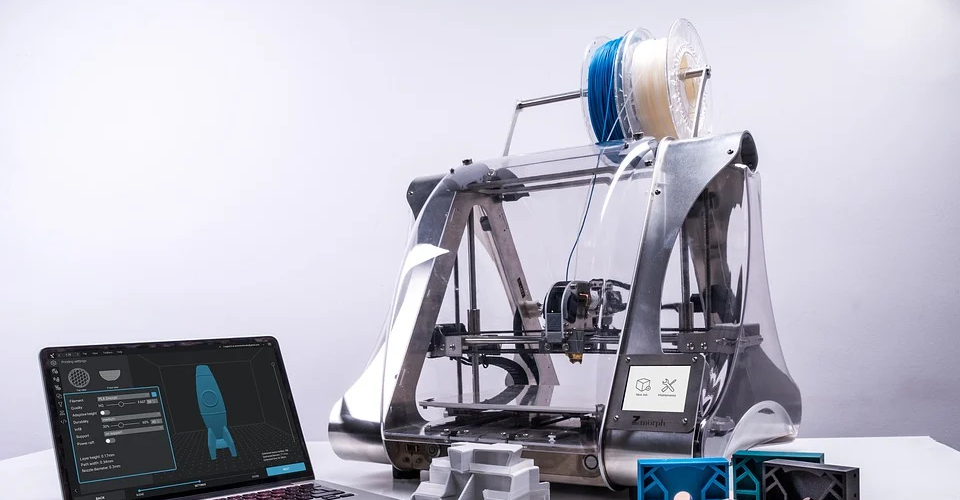How to Avoid Wasting Empty Filament Spools
3D printing may be an inherently waste-generating activity, but recent years have seen 3D printing professionals adopt more environmentally friendly practices. By using biodegradable plastics and recycling scrap prints to make new filament, there has been a concerted effort to reduce the solid waste from 3D printing. However, there is still one type of waste that is yet to be addressed fully – the empty filament spools.
Disposal of empty filament spools has been a perennial problem in 3D printing. It’s not unusual for a 3D printing firm to end up with hundreds of these empty spools in the space of a month. What can we do to avoid having these spools end up in a landfill?
1. Buy spools made of cardboard

An easy way to avoid having to deal with the plastic of empty spools is to buy spools that aren’t made of plastic. A few brands offer this option such as Proto-Pasta and SainSmart. Although the cardboard used in spools may not be fully biodegradable because of the inks and wax coatings, most local recycling facilities should be able to accept and process the cardboard spools.
There’s also the fact that cardboard is manufactured from sustainable sources. This may sound hypocritical when you’re buying what is essentially an entire roll on filament made from non-sustainable plastic. However, every little bit counts. We can both be responsible for how we use our plastic filaments and reduce the solid waste generated by empty spools.
If cardboard spools are so great, then why aren’t more brands using them? It all comes down to durability and customer preference. Even with the corrugated design of the cardboard spools of Proto-Pasta filaments, they are still much easier to deform than their plastic counterparts. Spool deformation can be a serious problem, as it can prevent the spool from spinning when mounted on a spool holder.
There’s also the matter of consumer preference. A lot of buyers feel short-changed when they receive a filament roll on a cardboard spool. This is especially true of Proto-Pasta because the brand sells filaments that are a little more expensive than usual.
Despite not receiving a unanimously favorable response from buyers, using cardboard spools seems to be the best way to help make 3D printing sustainable for now. With improvements in material and design, the use of cardboard spools may yet become a standard.
2. 3D print your own spool

Back in 2016, the concept of the Master Spool first gained popularity. The Master Spool is 3D-printable that opens apart and can be used to load filament onto. The design of the Master Spool has gone through several iterations and upgrade throughout the years but is still downloadable for free from Thingiverse.
The idea behind the Master Spool is that you can simply 3D print your own spool and order filaments that are packed with no spool. This allows for truly reusable spools so that old spools no longer need to be thrown out.
Responding to this movement, a few brands (such as 3D Solutech and FilaCube) have started to sell their filaments in forms that are compatible with the Master Spool design. If you’re not up to 3D printing your own Master Spool, there are also filaments that come with an included Master Spool which you can then re-use for your next orders.
Although there’s a lot of merit behind the idea for the Master Spool, a lot of users and manufacturers have not quite warmed up to the idea. Users of 3D printers who like having a collection of different filaments did not like having to print a new spool whenever they had to order a new filament. This is especially true of people who run 3D printing as a business they would rather spend their time 3D printing items that sell rather than an endless supply of empty spools!
Theoretically, selling filaments with no spools should help manufacturers by reducing material and shipping costs. However, most people tend to overlook the fact that the manufacturing process for filaments has to be overhauled to allow for “spool-less” filaments. New winding equipment has to be introduced and the filaments have to be packaged with zip ties. All these extra expenses effectively overshadowed any savings generated by not shipping the filaments with plastic spools.
Based on a survey done by filament brand Filamentive, almost two-thirds of their customer base still prefer buying filaments with cardboard spools compared to having to use Master Spools. The inconvenience of having to print your own spool and mounting the filament yourself probably plays a huge role in this user response.
3. Make new filament with a filament extruder

If you know what material the empty spool is made of, then it should be theoretically possible to chop it up into small pieces and make recycled filament out of it using a filament extruder. This is possible only if the spool is made of a thermoplastic, such as ABS.
Unfortunately, making filament out of an empty spool is easier said than done. It’s not just a matter of cutting the spool to pieces, melting them down, and extruding them through a nozzle. Most filament extruders are built to use plastic pellets as raw material as they are more consistent in shape and weight. There’s also the fact that empty filament spools may have dyes, adhesive, and other additives that make them difficult or impossible to recycle.
The idea is sound, but we haven’t heard of anyone demonstrating it with success. This can be attributed to filament extruders not very common in the first place because of how expensive they are and how difficult they are to operate.
If you do have an extruder and make your own filament, then you probably already use empty spools to wind them.
4. Reuse them in a variety of ways

If you’re not a heavy 3D printer user, then you probably don’t have to deal with hundreds of empty spools. One or two empty spools per month isn’t a huge problem with a bit of creativity. The good news is that there’s no shortage of creative ways posted online in which people have used their empty spools.
If you have anything that needs to be winded – such as electrical wires, Ethernet cables, and Christmas lights – then you might even be glad to have empty filament spools lying around. This is probably the least creative of these suggestions but the one that makes the most sense.
A design published in Thingiverse makes use of an empty filament spool as a desktop organizer. All you have to do is to 3D print these curved drawers that fit perfectly into the empty space of the spool. The product looks great, although there can only be so many of these “spool drawers” that you can use.
Empty filament spools have been used to make chandeliers, paint organizers, wheels for remote-controlled cars, clocks, laptop risers, lamps, and desk fans. There really are no guidelines on what you can do with these spools – if you have more ideas, we would love to hear them!
5. Return them to the manufacturer

Some companies who still sell filaments in plastic spools have instead created programs that will allow buyers to return their empty spools. Recognizing that it takes some work on the part of the buyer to recognize these spools, they also promote the behavior by offering incentives.
Filamentive spearheaded this movement back in 2017 when they offered a 20% discount for anyone who returns empty spools. The brand has since shifted to using cardboard spools, so the program is no longer as relevant. Another brand, Azure Film, has picked up on this initiative and offered a free 1-kilogram spool of PETG to anyone who will return 10 empty spools of their `1-kilogram filaments.
You may have noticed that big brands in the filament manufacturing market have no such programs for returns of empty spools. The truth is that it’s very hard for such an initiative to be economical. The company could stand to lose a lot of money if they shouldered the costs of shipping empty spools. Naturally, they also can’t expect the customers to handle these shipping costs.
Unless the logistical hurdle can be cleared, we are not likely to see the return of empty spools to manufacturers become standard practice.
Final thoughts
As 3D printing continues to gain popularity, dealing with the empty filament spools will also become a bigger problem. This is already pretty apparent in the various 3D printing forums where posts of users asking what to do with empty filament spools pop up seemingly every single week. The creative uses of filament spools are great but let’s face it – you can only make so many desktop organizers and lamps made out of empty spools before your house looks like a shelter in an apocalyptic wasteland.
Even today, 3D printing has been considered a niche manufacturing process or a hobby. Without any attention of regulatory bodies, the plastic waste generated by 3D printing has not been given the focus it deserves. This has led to attempts for self-regulation. Indeed, the movements to use cardboard spools or to develop the Master Spool design have been initiated either by filament manufacturers or individual 3D printing professionals.
With more and more people asking what they can do with empty filament spools, it is apparent that the efforts have not been enough. To effectively manage the plastic waste in 3D printing, there needs to be an industry-wide standard. It will take the concerted effort of filament manufacturers, 3D printer manufacturers, large 3D printing firms, and individual users for any meaningful change to come.


